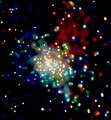ไฟล์:The Young Stellar Cluster RCW 38 in X-ray.jpg

ดูภาพที่มีความละเอียดสูงกว่า (2,100 × 2,279 พิกเซล, ขนาดไฟล์: 559 กิโลไบต์, ชนิดไมม์: image/jpeg)
| รูปภาพหรือไฟล์เสียงนี้ ต้นฉบับอยู่ที่ คอมมอนส์ รายละเอียดด้านล่าง เป็นข้อความที่แสดงผลจาก ไฟล์ต้นฉบับในคอมมอนส์
|
ความย่อ
| คำอธิบายThe Young Stellar Cluster RCW 38 in X-ray.jpg |
Description: This Chandra image covers a region about 5 light years across and shows many young stars with hot upper atmospheres. In addition to the point-like emission from the stars, the image revealed a diffuse cloud enveloping the star cluster. The X-ray spectrum of the cloud shows an excess of high-energy X-rays. This excess indicates that these X-rays come from trillion-volt electrons moving in a magnetic field. The presence of these extremely energetic particles could dramatically change the chemistry of the disks that will eventually form planets around stars in the cluster. Evidence in the form of short-lived radioactive nuclei found in meteorites suggests that our solar system was immersed for a time in a sea of energetic particles. Creator/Photographer: Chandra X-ray Observatory NASA's Chandra X-ray Observatory, which was launched and deployed by Space Shuttle Columbia on July 23, 1999, is the most sophisticated X-ray observatory built to date. The mirrors on Chandra are the largest, most precisely shaped and aligned, and smoothest mirrors ever constructed. Chandra is helping scientists better understand the hot, turbulent regions of space and answer fundamental questions about origin, evolution, and destiny of the Universe. The images Chandra makes are twenty-five times sharper than the best previous X-ray telescope. NASA's Marshall Space Flight Center in Huntsville, Ala., manages the Chandra program for NASA's Science Mission Directorate in Washington. The Smithsonian Astrophysical Observatory controls Chandra science and flight operations from the Chandra X-ray Center in Cambridge, Massachusetts. Medium: Chandra telescope x-ray Date: 2002 Persistent URL: chandra.harvard.edu/photo/2002/rcw38/ Repository: Smithsonian Astrophysical Observatory Gift line: NASA/CXC/CfA/S.Wolk et al. Accession number: rcw38_xray |
| วันที่ | |
| แหล่งที่มา | A young star cluster 6000 light years from Earth in the constellation Vela. |
| ผู้สร้างสรรค์ | Smithsonian Institution from United States |
| การอนุญาต (การใช้ไฟล์นี้ใหม่) |
Smithsonian Institution @ Flickr Commons |
การอนุญาตใช้สิทธิ
This image was taken from Flickr's The Commons. The uploading organization may have various reasons for determining that no known copyright restrictions exist, such as: No known copyright restrictionsNo restrictionshttps://www.flickr.com/commons/usage/false
More information can be found at https://flickr.com/commons/usage/. Please add additional copyright tags to this image if more specific information about copyright status can be determined. See Commons:Licensing for more information. |
| This image was originally posted to Flickr by Smithsonian Institution at https://flickr.com/photos/25053835@N03/2940665939. It was reviewed on 14 กันยายน พ.ศ. 2559 by FlickreviewR and was confirmed to be licensed under the terms of the No known copyright restrictions. |
14 กันยายน พ.ศ. 2559
คำบรรยายโดยย่อ
ไอเทมที่แสดงอยู่ในไฟล์นี้
ประกอบด้วย
บางค่าที่ไม่มีไอเทมวิกิสนเทศ
30 กันยายน 2008
ประวัติไฟล์
คลิกวันที่/เวลาเพื่อดูไฟล์ที่ปรากฏในขณะนั้น
| วันที่/เวลา | รูปย่อ | ขนาด | ผู้ใช้ | ความเห็น | |
|---|---|---|---|---|---|
| ปัจจุบัน | 14:34, 14 กันยายน 2559 |  | 2,100 × 2,279 (559 กิโลไบต์) | Vanished Account Byeznhpyxeuztibuo | Transferred from Flickr via Flickr2Commons |
หน้าที่มีภาพนี้
หน้าต่อไปนี้ โยงมาที่ภาพนี้:
การใช้ไฟล์ข้ามโครงการ
วิกิอื่นต่อไปนี้ใช้ไฟล์นี้:
- การใช้บน en.wikipedia.org
- การใช้บน fa.wikipedia.org
- การใช้บน ko.wikipedia.org
- การใช้บน mk.wikipedia.org
ข้อมูลเกี่ยวกับภาพ
ภาพนี้มีข้อมูลเพิ่มเติม ซึ่งส่วนใหญ่มาจากกล้องดิจิตอลหรือสแกนเนอร์ที่สามารถเก็บข้อมูลดังกล่าวไว้รวมกับภาพได้ ถ้าภาพนี้ถูกปรับปรุงแก้ไขหรือเปลี่ยนแปลงจากเดิม ข้อมูลบางอย่างจะยังคงไม่เปลี่ยนแปลงเหมือนภาพที่ถูกปรับปรุงแก้ไขนั้น
| ชื่อภาพ |
|
|---|---|
| ผู้ถ่าย | Chandra X-ray Observatory Center |
| ผู้ทรงลิขสิทธิ์ | http://chandra.harvard.edu/photo/image_use.html |
| พาดหัว | A young star cluster 6000 light years from Earth in the constellation Vela. |
| เครดิต/ผู้จัดเตรียม | NASA/CXC/CfA/S.Wolk et al. |
| ต้นฉบับ | Chandra X-ray Observatory |
| คำกล่าวลิขสิทธิ์ออนไลน์ | |
| ข้อตกลงในการใช้งาน | |
| เวลาที่บันทึกภาพ | 18 ธันวาคม 2545 |
| ความกว้าง | 2,100 พิกเซล |
| ความสูง | 2,279 พิกเซล |
| บิตต่อคอมโพเนนต์ |
|
| รูปแบบการบีบอัด | LZW |
| พิกเซลคอมโพซิชัน | RGB |
| การจัดวางภาพ | ปกติ |
| จำนวนคอมโพเนนต์ | 3 |
| ความละเอียดแนวนอน | 300 dpi |
| ความละเอียดแนวตั้ง | 300 dpi |
| การจัดเรียงข้อมูล | รูปแบบชังกี |
| ซอฟต์แวร์ที่ใช้ | Adobe Photoshop CS3 Macintosh |
| แก้ไขภาพล่าสุด | 10:34, 30 กันยายน 2551 |
| สเปซสี | ไม่ได้ปรับเทียบ |
| ความกว้างของภาพ | 2,100 พิกเซล |
| ความสูงของภาพ | 2,279 พิกเซล |
| รุ่นเอกซิฟ (Exif) | 2.21 |
| เวลาที่แปลงเป็นดิจิทัล | 06:34, 30 กันยายน 2551 |
| วันที่แก้ไขข้อมูลเมตาล่าสุด | 14:39, 8 ตุลาคม 2551 |
| คำสำคัญ | RCW 38 |
| ข้อมูลสำหรับติดต่อ | cxcpub@cfa.harvard.edu
60 Garden st. Cambridge, MA, 02138 USA |
| รุ่น IIM | 2 |